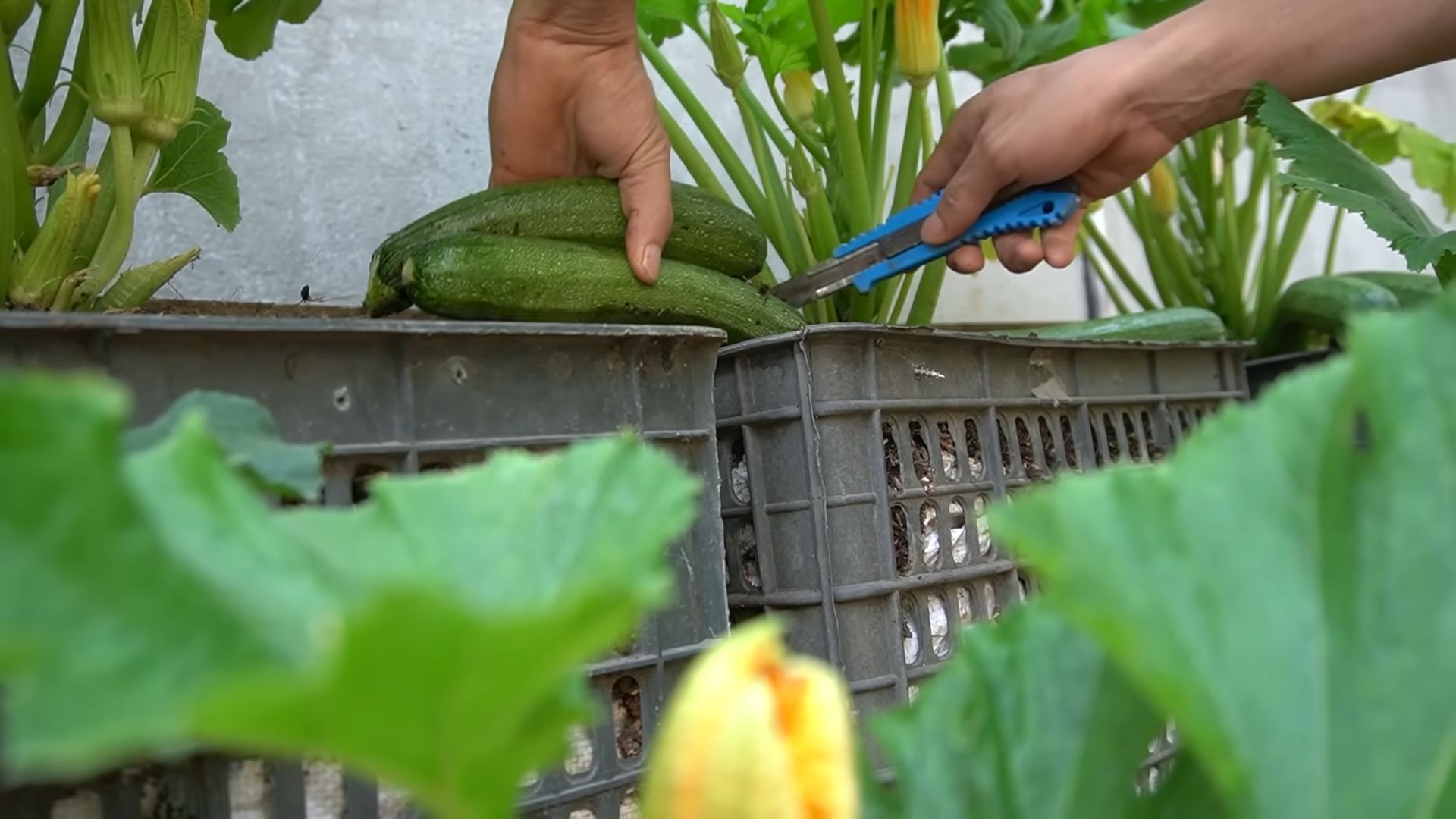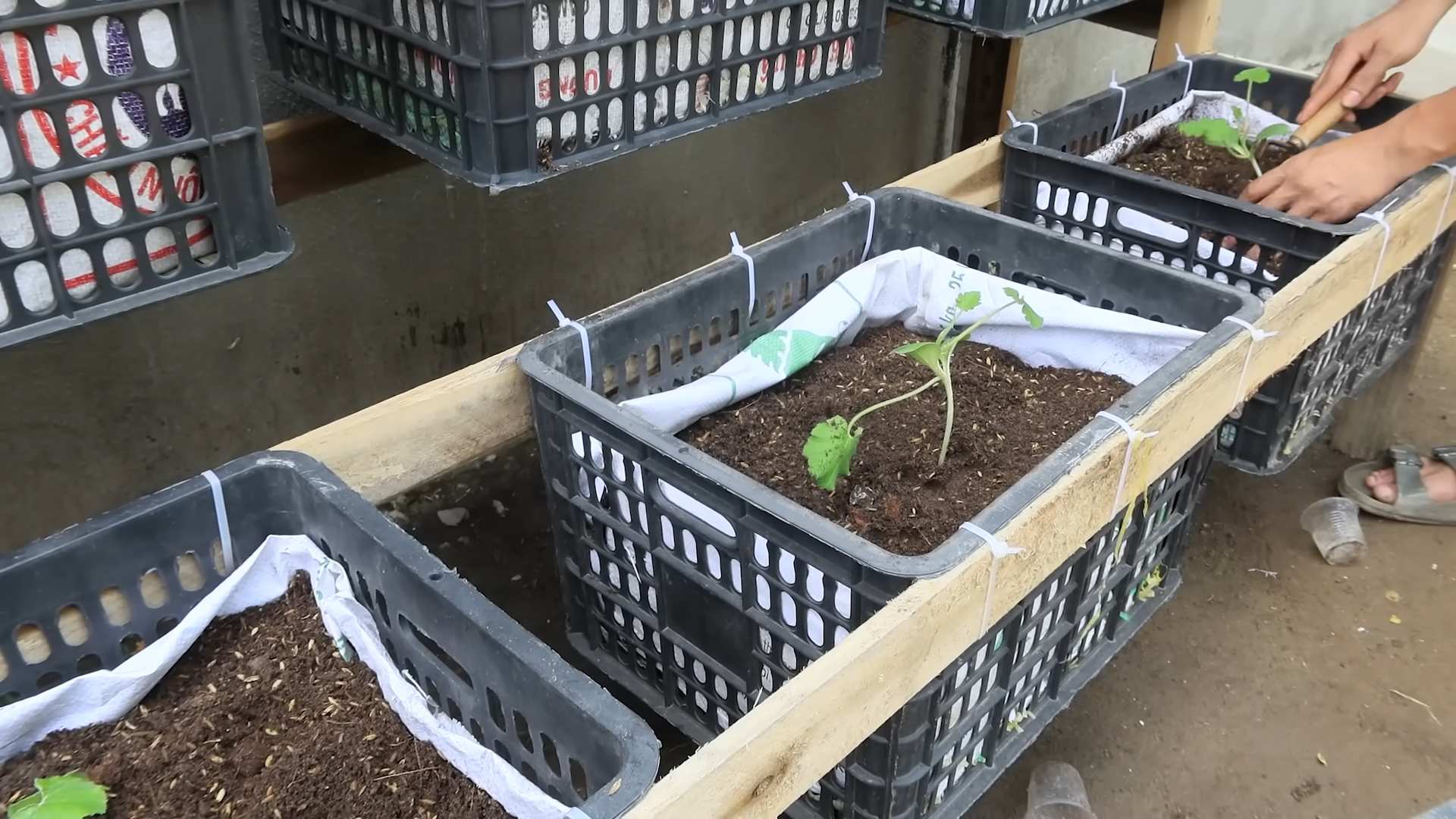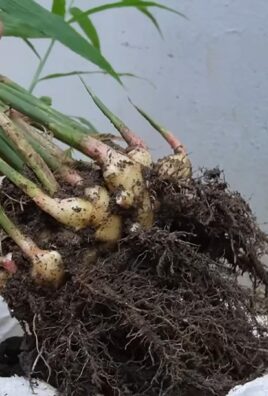Grow Zucchini at Home? Absolutely! Imagine stepping into your backyard and harvesting fresh, vibrant zucchini, ready to be transformed into delicious meals. Forget those bland, store-bought vegetables – with a few simple tricks, you can cultivate a thriving zucchini patch right outside your door.
For centuries, zucchini, a member of the squash family, has been a staple in cuisines worldwide. Originating in the Americas, it made its way to Europe and beyond, becoming a beloved ingredient in everything from ratatouille to zucchini bread. But why settle for buying zucchini when you can experience the joy of growing your own?
In today’s world, where we’re increasingly conscious of where our food comes from, growing zucchini at home offers a fantastic way to connect with nature and enjoy fresh, healthy produce. Plus, let’s be honest, zucchini plants are incredibly prolific! One or two plants can provide you with an abundance of zucchini throughout the growing season. This DIY guide will equip you with the knowledge and simple hacks to successfully grow zucchini at home, even if you have limited space or gardening experience. I’m excited to share these tips with you, so let’s get started and transform your garden into a zucchini paradise!

Growing Zucchini: A Beginner’s Guide to Bountiful Harvests
Hey there, fellow gardening enthusiasts! I’m so excited to share my experiences and tips on growing zucchini at home. Zucchini is a fantastic vegetable to grow, especially for beginners, because it’s relatively easy, fast-growing, and incredibly productive. Get ready for a summer filled with delicious zucchini bread, grilled zucchini, and so much more!
Choosing Your Zucchini Variety
Before we dive into the nitty-gritty, let’s talk about zucchini varieties. There are tons of options, each with its own unique characteristics. Here are a few popular choices:
* Black Beauty: This is a classic, reliable variety that produces dark green, almost black, fruits. It’s known for its excellent flavor and productivity.
* Costata Romanesco: If you’re looking for something a little different, this Italian heirloom variety has beautiful ribbed fruits with a nutty flavor.
* Golden Zucchini: As the name suggests, this variety produces bright yellow fruits. It’s just as easy to grow as green zucchini and adds a pop of color to your garden.
* Round Zucchini (Eight Ball, One Ball): These varieties produce cute, round fruits that are perfect for stuffing.
I personally love growing Black Beauty because it’s so dependable, but feel free to experiment and find your favorite!
Getting Started: Planting Your Zucchini
Zucchini is a warm-weather crop, so it’s important to wait until the danger of frost has passed before planting. Here’s how to get your zucchini plants off to a great start:
1. Choose the Right Location: Zucchini plants need at least 6-8 hours of sunlight per day. They also need plenty of space, as they can grow quite large. Choose a location in your garden that gets plenty of sun and has well-drained soil.
2. Prepare the Soil: Zucchini plants thrive in rich, fertile soil. Before planting, amend your soil with plenty of compost or well-rotted manure. This will provide your plants with the nutrients they need to grow strong and healthy. I usually dig in a generous amount of compost a few weeks before planting.
3. Starting Seeds Indoors (Optional): You can start zucchini seeds indoors about 3-4 weeks before the last expected frost. This will give you a head start on the growing season. Sow the seeds in small pots or seed trays filled with seed-starting mix. Keep the soil moist and warm, and the seeds should germinate in about a week.
4. Direct Sowing: If you prefer to direct sow your zucchini seeds, wait until the soil has warmed up to at least 60°F (15°C). Sow the seeds about 1 inch deep and 2-3 feet apart. Water well after planting.
5. Transplanting Seedlings: If you started your zucchini seeds indoors, harden them off before transplanting them into the garden. This means gradually exposing them to outdoor conditions over a period of a week or two. Once the danger of frost has passed, transplant the seedlings into the garden, spacing them 2-3 feet apart.
Caring for Your Zucchini Plants
Once your zucchini plants are in the ground, it’s important to provide them with the care they need to thrive. Here’s what you need to do:
1. Watering: Zucchini plants need consistent moisture, especially during hot, dry weather. Water deeply and regularly, aiming to keep the soil consistently moist but not waterlogged. I usually water my zucchini plants in the morning to allow the foliage to dry before nightfall, which helps prevent fungal diseases.
2. Fertilizing: Zucchini plants are heavy feeders, so it’s important to fertilize them regularly. Use a balanced fertilizer, such as 10-10-10, according to the package directions. You can also side-dress your plants with compost or well-rotted manure every few weeks.
3. Mulching: Mulching around your zucchini plants will help to conserve moisture, suppress weeds, and regulate soil temperature. Use organic mulch, such as straw, wood chips, or shredded leaves.
4. Pest and Disease Control: Zucchini plants can be susceptible to a few pests and diseases, such as squash bugs, squash vine borers, and powdery mildew. Inspect your plants regularly for signs of pests or diseases, and take action promptly if you find any problems. I like to use organic pest control methods whenever possible, such as hand-picking pests or using insecticidal soap.
5. Pollination: Zucchini plants have separate male and female flowers. The female flowers need to be pollinated in order to produce fruit. If you’re not seeing any fruit developing, you may need to hand-pollinate the flowers. To do this, simply use a small paintbrush to transfer pollen from the male flowers to the female flowers. The female flowers have a small zucchini fruit behind the flower, while the male flowers have a straight stem.
Harvesting Your Zucchini
One of the best things about growing zucchini is that you can start harvesting it relatively quickly. Here’s what you need to know:
1. When to Harvest: Zucchini is best harvested when it’s young and tender, typically when it’s about 6-8 inches long. If you let it grow too large, it can become tough and seedy.
2. How to Harvest: Use a sharp knife or pruning shears to cut the zucchini from the plant. Be careful not to damage the plant.
3. Harvesting Regularly: The more you harvest your zucchini, the more it will produce. Check your plants every day or two and harvest any zucchini that are ready.
4. Dealing with a Zucchini Glut: Zucchini plants are incredibly productive, so you may find yourself with more zucchini than you know what to do with! Don’t worry, there are plenty of ways to use up your zucchini. You can make zucchini bread, zucchini muffins, zucchini soup, grilled zucchini, zucchini noodles, and so much more. You can also freeze or can zucchini for later use.
Troubleshooting Common Zucchini Problems
Even with the best care, you may encounter some problems when growing zucchini. Here are a few common issues and how to address them:
* Powdery Mildew: This fungal disease can cause a white, powdery coating on the leaves of your zucchini plants. To prevent powdery mildew, make sure your plants have good air circulation and avoid overhead watering. If you see signs of powdery mildew, you can treat it with a fungicide.
* Squash Bugs: These pests can suck the sap from your zucchini plants, causing them to wilt and die. Hand-pick squash bugs off your plants or use insecticidal soap.
* Squash Vine Borers: These pests bore into the stems of your zucchini plants, causing them to wilt and die. To prevent squash vine borers, wrap the stems of your plants with aluminum foil or netting. If you see signs of squash vine borers, you can try to remove them by slitting the stem and pulling them out.
* Lack of Pollination: If your zucchini plants are not producing fruit, it may be due to a lack of pollination. Hand-pollinate the flowers or attract pollinators to your garden by planting flowers that they love.
Extending Your Zucchini Season
Want to enjoy fresh zucchini for as long as possible? Here are a few tips for extending your zucchini season:
* Succession Planting: Plant zucchini seeds every few weeks to ensure a continuous harvest throughout the summer.
* Cold Frames or Row Covers: Use cold frames or row covers to protect your zucchini plants from frost in the spring and fall.
* Choose Early-Maturing Varieties: Select zucchini varieties that mature quickly to get a head start on the growing season.
My Favorite Zucchini Recipes
Okay, now for the fun part! Here are a few of my favorite zucchini recipes:
* Zucchini Bread: This is a classic for a reason! It’s moist, delicious, and perfect for using up lots of zucchini.
* Grilled Zucchini: Simply slice zucchini lengthwise, brush with olive oil, and grill until tender. Season with salt, pepper, and your favorite herbs.
* Zucchini Noodles (Zoodles): Use a spiralizer to turn zucchini into noodles. Toss with your favorite sauce or pesto.
* Zucchini Fritters: Grate zucchini, mix with flour, eggs, and seasonings, and fry until golden brown.
Final Thoughts
Growing zucchini at home is a rewarding experience. With a little bit of care and attention, you can enjoy a bountiful harvest of fresh, delicious zucchini all summer long. So get out there, plant some seeds, and get ready to enjoy the fruits (or vegetables!) of your labor! Happy gardening!

Conclusion
So, there you have it! Growing zucchini at home is not only achievable, but it’s also incredibly rewarding. Forget those bland, store-bought zucchinis that lack flavor and character. With a little effort and these simple DIY tricks, you can cultivate a bounty of fresh, vibrant zucchini right in your own backyard or even on your balcony.
Why is this a must-try? Because the taste difference is undeniable. Homegrown zucchini boasts a sweetness and tenderness that you simply can’t find in commercially grown varieties. Plus, you have complete control over the growing process, ensuring that your zucchini is free from harmful pesticides and chemicals. You’re not just growing vegetables; you’re growing peace of mind.
Beyond the superior taste and health benefits, growing zucchini at home is also a fantastic way to connect with nature, reduce your carbon footprint, and save money on groceries. Imagine the satisfaction of harvesting your own zucchini and using it to create delicious meals for your family and friends.
Ready to take your zucchini game to the next level? Consider these variations and suggestions:
* Vertical Gardening: If you’re short on space, try growing zucchini vertically using trellises or cages. This not only saves space but also improves air circulation, reducing the risk of fungal diseases.
* Companion Planting: Plant zucchini alongside beneficial companion plants like marigolds, nasturtiums, or basil. These plants can help deter pests and attract pollinators, leading to a healthier and more productive zucchini crop.
* Heirloom Varieties: Experiment with different heirloom zucchini varieties like ‘Costata Romanesco’ or ‘Black Beauty’ for unique flavors and textures.
* Zucchini Flowers: Don’t forget about the zucchini flowers! These delicate blossoms are edible and can be used in a variety of culinary creations, from stuffed zucchini flowers to tempura.
* Succession Planting: To ensure a continuous harvest throughout the growing season, try succession planting. Sow new zucchini seeds every few weeks to stagger your harvests.
Growing zucchini at home is more than just a gardening project; it’s an investment in your health, your taste buds, and your connection to the natural world. It’s a chance to experience the joy of nurturing a plant from seed to harvest and to savor the fruits (or rather, vegetables) of your labor.
We encourage you to give these DIY tricks a try and experience the magic of homegrown zucchini for yourself. Don’t be afraid to experiment, adapt, and find what works best for your unique growing conditions. And most importantly, don’t forget to share your experiences with us! We’d love to hear your tips, tricks, and zucchini-growing success stories in the comments below. Let’s build a community of passionate home gardeners and celebrate the joys of growing zucchini at home together!
Now, go forth and grow some zucchini! You won’t regret it.
Frequently Asked Questions (FAQ)
What is the best time to start growing zucchini at home?
The ideal time to start growing zucchini is after the last frost in your area. Zucchini is a warm-weather crop and is sensitive to cold temperatures. You can start seeds indoors about 3-4 weeks before the last expected frost date to get a head start. If you’re planting directly in the ground, wait until the soil has warmed up to at least 60°F (15°C). Check your local weather forecast and planting guides for specific recommendations for your region.
How much space does a zucchini plant need?
Zucchini plants can grow quite large, so it’s important to give them enough space to thrive. As a general rule, allow at least 2-3 feet between plants. If you’re growing zucchini in rows, space the rows about 3-4 feet apart. Consider the mature size of the specific variety you’re growing, as some varieties may require even more space. Vertical gardening with trellises can help maximize space if you have a smaller garden.
What kind of soil is best for growing zucchini?
Zucchini plants prefer well-drained, fertile soil that is rich in organic matter. Amend your soil with compost or well-rotted manure before planting to improve its fertility and drainage. A slightly acidic to neutral soil pH (around 6.0-7.0) is ideal. You can test your soil pH using a soil testing kit and adjust it accordingly with lime or sulfur.
How often should I water my zucchini plants?
Zucchini plants need consistent moisture, especially during hot, dry weather. Water deeply and regularly, aiming to keep the soil consistently moist but not waterlogged. Water at the base of the plant to avoid wetting the foliage, which can increase the risk of fungal diseases. Mulching around the plants can help retain moisture and suppress weeds. Check the soil moisture regularly and adjust your watering schedule as needed based on weather conditions.
What are some common pests and diseases that affect zucchini plants?
Zucchini plants can be susceptible to a variety of pests and diseases, including squash bugs, squash vine borers, aphids, powdery mildew, and blossom end rot. Regularly inspect your plants for signs of pests or diseases and take action promptly to prevent them from spreading. Use organic pest control methods like insecticidal soap, neem oil, or handpicking pests. Ensure good air circulation around your plants to reduce the risk of fungal diseases. Blossom end rot is often caused by calcium deficiency or inconsistent watering, so ensure your plants receive adequate calcium and consistent moisture.
How do I know when my zucchini is ready to harvest?
Zucchini is typically ready to harvest about 50-65 days after planting. The ideal size for harvesting zucchini depends on the variety, but generally, you should harvest them when they are about 6-8 inches long. Overgrown zucchini can become tough and seedy. Check your plants regularly and harvest zucchini when they are young and tender. Use a sharp knife or pruning shears to cut the zucchini from the plant, leaving a short stem attached.
Can I eat zucchini flowers?
Yes, zucchini flowers are edible and can be used in a variety of culinary dishes. They have a delicate, slightly sweet flavor and can be stuffed, fried, or added to salads. Harvest the male flowers (those without a small zucchini fruit attached) to avoid reducing your zucchini yield. Harvest the flowers in the morning when they are fully open.
How can I prevent blossom end rot in my zucchini?
Blossom end rot is a common problem in zucchini, characterized by a dark, sunken spot on the blossom end of the fruit. It’s often caused by calcium deficiency or inconsistent watering. To prevent blossom end rot, ensure your soil is rich in calcium and water your plants consistently, especially during hot, dry weather. You can also add calcium to the soil by amending it with bone meal or crushed eggshells. Avoid over-fertilizing with nitrogen, as this can interfere with calcium uptake.
What can I do with an overabundance of zucchini?
If you find yourself with an overabundance of zucchini, don’t worry! There are countless ways to use it. You can grate it and add it to baked goods like zucchini bread, muffins, or cakes. You can spiralize it into zucchini noodles (zoodles) for a healthy pasta alternative. You can sauté it, grill it, or roast it as a side dish. You can also freeze zucchini for later use. Grate the zucchini, squeeze out the excess moisture, and freeze it in freezer bags or containers. You can also pickle zucchini or make zucchini relish.
How do I save zucchini seeds for next year?
To save zucchini seeds for next year, allow a few zucchini fruits to mature fully on the plant. These zucchini will become very large and the skin will harden. Once the zucchini is fully mature, cut it open and scoop out the seeds. Rinse the seeds thoroughly to remove any pulp. Spread the seeds out on a paper towel to dry completely. Once the seeds are dry, store them in an airtight container in a cool, dark, and dry place. Properly stored zucchini seeds can remain viable for several years.




Leave a Comment